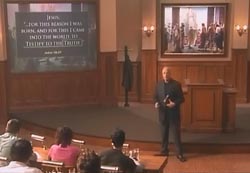Don’t fall prey to logical traps, old arguments, or the emotional baiting of evolutionists.
 “It’s over Anakin, I have the high ground.” |
||||
| In my previous post I referenced an article titled “The Top 10 Signs that You Don’t Understand Evolution at All” which is really a restatement of objections that evolutionists believe they have adequately answered, while at the same time lightly(?) mocking creationists – as evolutionists are wont to do. (Whether lightly or not I’ll leave to you.) As is typical in a list like this, the more important questions (for which they have no answer) are not even mentioned much less given adequate answers to. But since I couldn’t bear the thought of leaving you hanging without the answers having myself referenced the article, here are responses to show none of these issues are problems for rational thinking Christians. A word of warning before we begin: Since he couches many of these statements in broad universals (“never,” “always,” etc. – which is a dead give away that the statement is almost certainly untrue and a good candidate for the “all or nothing” logical fallacy); it follows that the position he’s trying to ridicule may be technically untrue, but the point beneath the ridicule that he’s trying to make has been thoroughly refuted as I note below. Below in bold is Tyler Francke’s list of “The top 10 signs that you don’t understand evolution at all” with my explanations following immediately; and so there is no mistake on who’s saying what, my comments are indicated by my initials.
DC>He makes a number of questionable statements here, I’ll just point out a couple. First he notes:
DC>Evolution of the type we’re talking about – molecules to man is not observable. Like many evolutionists he is committing the logical error of equivocation – using the term evolution in more than one sense (which is commonly done to win arguments, though it’s logically fallacious). Natural selection (which is not evolution) is observable; molecules to man evolution is not. Second, he goes on to talk about an inference to the best explanation (which I drew upon in my last article) but intelligent design theorists and creationists alike, (not to mention scientists who dissent from evolutionary theory) would say given the evidence, such as the fossil evidence below, he has not drawn an inference to the best explanation by believing it points to evolution. He states:
DC>I would challenge him that it is not the evidence that points him to evolution, it’s his a priori beliefs (science is authoritative over scripture) that lead him to the conclusion that evolution is true because judging by evidence alone, (such as the evidence from DNA, the young solar system, etc.) the correct conclusion is that there was an intelligent designer. 2. You think we’ve never found a transitional fossil. DC>This is frankly very misleading. A more precise statement would be Continue Reading |
Category Archives: Evidence
The Poor Marksmanship of Evolutionists
Evolutionists claim to be answering a problem posed to them, but they often avoid the problem or miss the mark.
 Kahn: Kirk – You’re still alive old friend. Kahn: Kirk – You’re still alive old friend.
Kirk: Still, – “old friend”. You’ve managed to kill everyone else, but like a poor marksman, you keep missing the target! And so admiral1 Kirk taunts Kahn, a genetically engineered “super” human who is supposed to be superior to us mere humans in every way – physically, mentally etc. In another classic line, when Kirk is trying to get Kahn to follow the Enterprise into a nebulae where both ships would lose the benefits of key systems such as shields, Kirk taunts Kahn again, saying “I’m laughing at the superior intellect,” a taunt sufficient enough to get Kahn to follow them in. I don’t mean to taunt the poor misguided evolutionists, but I do hope the air of superiority they tend to express motivates them to try to provide an answer to the questions posed in the post “Windtalkers and DNA” because the responses I’ve had so far don’t address the issues. So like Kirk I say, like poor marksmen, they keep missing the target of the difficulties that DNA poses. So let me spell it out the difficulties for them, – and give them a clear target to hit. But first here is a sample of the poor marksmanship: Continue Reading |
The Best Reason for Apologetics

As you might imagine of one hosting a website that deals with apologetic issues, I listened with interest to the debate last Saturday on Moody’s Up For Debate entitled “Do Apologetics Help or Hurt our Christian Witness?” As always the host, Julie Roys welcomed well qualified guests for the discussion: author and professor David Fitch and author and professor Nancy Pearcey. Dr. Fitch offered the concern that apologetics train us in a posture of defensiveness; and that we don’t listen as well, having answers ready before we hear the question. His main objection is summarized in this tweet:
We have a posture of defensiveness which is not needed. Rather we need to embody the story God is telling through us. – #DavidFitch
— Up for Debate Radio (@Up4DebateRadio) March 8, 2014
Professor Pearcey had a number of good responses, in addition to her own testimony of how apologetics helped her come to the faith, some of her reminders include:
– We need to be inclusive in our approaches
– We should use all the tools available to us
– It is possible to do apologetics wrong (implied: therefore learn to do it right!)
– Apologetics can descend into a game of “gotcha”
– And as she reminded us in this tweet:
#Apologetics assists in making ones understanding not simply emotional but intellectually. – #NancyPearcey
— Up for Debate Radio (@Up4DebateRadio) March 8, 2014
But the answer I was expecting, Continue Reading
Windtalkers and DNA
 |
DNA – a highly complex very efficient information storage and retrieval system |
In the 2002 movie “Windtalkers”, Sergeant Joe Enders, played by Nicholas Cage is given this charge: “Protect the code.” It’s World War II and the Marines are using the code for critical tactical communications that they cannot afford to have intercepted. They’ve developed a unique code that proves to be unbreakable. That’s because it’s double coded.
According to this Wikipedia article, in a moment of luck mixed with a touch of genius reminiscent of the insight highlighted in “A Beautiful Mind”, Captain Lawrence of the U.S. Army overheard two men speaking in the Choctaw native American language – and had an inspiration for the code. The article gives further details on the “Code Talkers” but the point I want to make is this: The communication employed by the Marines was coded. Coded information always requires someone – an intelligence – to create the code. If that is not obvious, this particular case clarifies things because the communication is double coded – which highlights the intelligence required. It’s quite obvious that there is no process in the universe that can create double coded information without an intelligence behind it.
Consider the complexity of creating and decoding a double coded message. Suppose the word they wanted to communicate was “Plateau”. Plateau may be coded (in English) to the word “horse”. “Horse” would then be translated into the word used in the Choctaw language for horse, which is issuba.1 The process looks something like this:
Plateau > Code word: Horse >Horse re-coded : issuba
Notice the process of mapping meaning to a symbol that takes place. It’s clear to see why this code was unbreakable. Even if they could catch the syllables of the Choctaw words which were spoken (which would have been difficult enough) – the enemy wouldn’t know what those syllables “is-su-ba” meant. Let’s say the enemy managed to catch the word, they next have to determine the convention used. It’s not English, French, Spanish, etc. They need to figure out the language convention: Choctaw. If they manage to figure that, they additionally need to find someone who speaks Choctaw. If you do, you now have the meaning of the word in Choctaw – “horse” but you still haven’t intercepted the message, because the message is still in code. “Horse” isn’t the message, “horse” must be again decoded by an intelligence to retrieve the originally intended message using yet another code. And for that you must have the code. And I’ll say it again because it’s a critical point: Codes are not created by random processes, they are the result of an intelligence. Intelligence is required to create a code, to encode a message, and to create a process to decode the message.
Clearly coded messages require intelligence. Both to encode and decode. But in fact the need for intelligence goes beyond that. The coder must use a system of pre-defined symbols as the medium by which the coded message is transferred or carried. (And if one does not exist, the communicator must create such a system.) For example on this web page, the system employed is the specially formed black marks called “letters” used to represent small units of meaning that represent sound. The letters are then formed into a concept by arranging them in the pre-selected units of the code or language, in this case English words. Once the concepts are encoded into words, an intelligence must further arrange the words to communicate something even more complex: a complete message – a phrase conveying meaning. Consider this string of letters and characters:
lb)rah ured(e sy(eir)
It has what appears to be letters arranged into words, but it is meaningless. This is what you get from random processes – Darwinian processes. Now consider the same letters, after being arranged by an intelligence into words – which when strung together with further intelligence, properly convey meaningful information:
(red hair) (blue eyes)
So an intelligent coder uses the letters of a pre-defined system (or creates one), and superimposes a pre-defined message (in this case hair color, eye color) on those letters by arranging them according to a pre-defined code (or language) such that the component parts (the individual words) communicate the intended message when decoded by the pre-defined code (in this case the code is the English language). This process of information encoding and decoding is far beyond what random processes alone can achieve. Random processes could not even create a complete set of letters, much less a word or message.
Now consider DNA. DNA is highly complex, very efficient information storage and retrieval system. It contains coded information. There is not a biologist (or any other scientist) in the world that denies these facts. Consider what this means. For DNA to have originated, the following would have had to have occurred:
1. An intelligent designer had to create a system of symbols to carry the message. In the case of DNA it is a chemical alphabet that scientist represent by the letters ACGT – representing the nucleobases in DNA – Adenine, Cytosine, Guanine, Thymine. These function as the letters of an alphabet
2. An intelligent designer had to create a “language” that communicates a message when the 4 letters are arranged in a certain way.
3. An intelligent designer had to arrange the letters in an intelligent, specific ways to encode and transmit the instructions necessary to create chemical words that specify the various traits we see in the many creatures that exist – such traits being things like hair color or eye color.
4. An intelligent designer had create a system capable of decoding the coded message.
On this point of the information bearing properties of DNA, Stephen Meyer, philosopher of science and author of the book “Signature in the Cell” which details this process correctly observes:
“NeoDarwinism and its associated theories of chemical evolution and the like will not be able to survive the biology of the information age, the biology of the 21st century.”2
The random processes claimed for evolution are simply incapable of creating such a system because random processes do not create complex, specific, organized information nor the systems that store such information. Since evolution could not have created DNA, those seriously seeking the truth about the origins of life are left bereft of any plausible naturalistic explanation. Since evolution is eliminated as an explanation for the origins of life (which Darwinism never provided in the first place3), the only source of such a super complex information storage and retrieval system and the information contained within – is an intelligence capable of creating them both. In the face of such clearly designed, intelligent systems and complexly coded information, Darwinian random processes and undirected mutations don’t stand a chance. For those seriously seeking the truth, I direct you to a testimony of the Creator:
For you created my inmost being; you knit me together in my mother’s womb. I praise you because I am fearfully and wonderfully made; your works are wonderful, I know that full well.
Psalm 139.13-14
As this testimony from the psalms of David shows, the works of the Creator are evident even without knowledge of the complexities of DNA. Truly, those with knowledge of DNA and still denying God are “without excuse.”4
Duane Caldwell – posted 2-26-2014, revised 12/29/2015 | Print Format
Follow @duanecaldwell
Notes
1 Chahta Anumpa Aiikhvna, School of Choctaw Language, 2013
http://www.choctawschool.com/vocabulary/vocabulary/for-all-chapters.aspx
2 Stephen Meyer in Lee Strobel’s DVD Documentary “The Case for a Creator”, Illustra Media, 2006
3 Darwinian Evolution cannot operate until life already exists. Thus claims that processes like natural selection created DNA are non-starters since natural selection cannot operate until life (include DNA) already exists. So much for Dawkin’s “intellectual fulfillment”. (Richard Dawkins says evolution allows him to be a “intellectually fulfilled” atheist The Blind Watchmaker (1986), page 6)
4 The Apostle Paul, Romans 1.20
Image: DNA – Public Domain, National Institutes of Health
Red Pandas, Trees and Orchards
 |
Problems for Darwin’s Tree of Life: The Red Panda doesn’t fit; nor do a host of other creatures, vindicating the biblical account of creation by kinds. |
In the recent Ken Ham vs Bill Nye debate on origins (which one tweeter aptly named the Ham on Nye debate) based on some comments I’ve heard, it seems to me that a number of people missed one of the main points Ham was making. And since one the reasons for this blog is to defend the Biblical account of origins let me revisit that point here.
Ham pointed out that the Bible makes specific claims about origins – the origins of the solar system, of people, of all creatures. In contrast the theory that allows Richard Dawkins to be an “intellectually fulfilled atheist” – Darwinian evolution – also makes claims – quite different claims. So the question is which explanation better fits the evidence? On the one hand, in a doctrine known as “common descent” Darwinian evolution claims that all creatures are descendents of a single ancestor. That means that all creatures are related and are part of what’s known as the evolutionary tree of life.
On the other hand the Bible claims that creatures were created by God, “according to their kind” (Gen 1.21, 24, 25, etc.). Continue Reading
Saturn’s Rings are Young!

Above: Saturn as seen when space craft Cassini flew by. (2013)
Pick anyone living in the world today. What could you say you know about them? Well for one, you could say you know they weren’t alive at the time of Christ. How do you know that? Well we know Christ lived some 2000 years ago. We also know that humans do not live for 2000 years. And though life spans vary, most do not live much beyond 100 years. So if you come across a living person, you know that person was not alive to see Christ; for if they were alive during Christ’s time, they wouldn’t be alive now.
That is the scenario we have with the Rings of Saturn. Scientists have calculated the “life span” of the rings, and it is not at all in line with what they calculate the age of either the solar system or Saturn. So if the rings are “alive” now, they must be relatively young; for if they were as old scientists say the rest of the solar system is – some 4.6 billion years – they would have long ago vanished. Continue Reading
